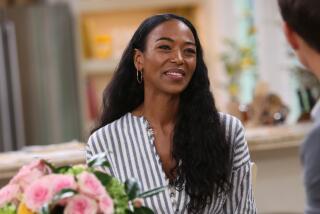Battling Cancer With Courage and Style : Valor: Lawyer Bonnie Reading’s indefatigable optimism and good-natured determination make her an inspiration.
- Share via
Bonnie Reading is one of those women who seems to have it all.
Her resume reads like this: High school cheerleader. College homecoming queen. Ivy League grad. Star student at law school. Law review. First female partner at one of San Diego’s old-line law firms. Successful divorce lawyer. Mother of twins. Tennis addict. Golf nut.
And now, just 48, seriously ill with cancer. But, still out to make the world her own, she remains optimistic, cheerful and sweetly inspirational.
“Part of me really resents this added line on my resume,” Reading said. “But people always say to me, ‘How do you manage?’ Or, ‘You’re so courageous.’ I always say, ‘Cancer is not a full-time job. It doesn’t take that much time.’ I have the things I’ve always had--friends, family, job. I’ve got to go on with my life.”
The past two weeks, Reading has been at a clinic in Little Rock, Ark., enduring the second phase of an experimental bone marrow transplant that might or might not give her a new lease on her full life--a treatment aimed at arresting her disease, called multiple myeloma.
She has a large and vocal rooting section, made up not only of her family and friends but the partners and junior lawyers at her law firm and the rest of the bench and bar in San Diego.
By all accounts, it’s because her upbeat attitude is so infectious. She’s a real pro in the nastiest business going--divorce lawyering. Yet the last time she was back in Arkansas, last November for the first phase of treatment, here were all these courtroom sharks suddenly showing a tender side, sending her fan mail and showering her with get-well faxes.
This time around, for phase two, it was the same thing--another file folder full of best wishes, she said.
“I just get so many cards and letters,” she said. “It pays to advertise. It keeps me going.”
Actually, said her friends and colleagues, it’s she who keeps them going.
“No one is a saint or perfect,” said San Diego Superior Court Judge Thomas Ashworth, who has known Reading for more than 20 years and frequently litigated divorce cases with her before he took the bench. “But the thing that stands out to me is, I have never seen her down.
“It’s real unusual,” Ashworth said. “She doesn’t draw strength from other people. She gives something to them and makes them feel better for it.”
Reading’s closest friends include a group of women who were among San Diego’s first female attorneys in the 1970s. Her disease has forced this closely knit group--five current judges and three other lawyers besides Reading, all pals for years--to take a hard look at where they’ve been and what’s to come.
“At its essence, Bonnie’s struggle is really a celebration of life,” said Judith Keep, the chief judge of the San Diego federal court.
“The more she struggles, the more she fights with her great humor, the more we realize what a precious commodity time is, that you can’t squander it,” Keep said. “I know that’s a trite lesson. The problem is, you have to be reminded of this every so often.
“Going through this with a friend who is going through it with passion and humor makes you reassess what’s important,” Keep said. “She’s made us cherish life more. It’s ironic but true.”
It’s the small things that Reading’s friends particularly cherish, the telling details of her bravery and charm.
For years, Reading has played tennis every Wednesday with Keep and two other women. Cancer was not about to cancel that, even in recent months when chemotherapy robbed Reading of her hair.
At the last game before Reading went to Little Rock, it became clear that her wig wouldn’t do because her scalp would get too sweaty, Keep said. So, ever organized, she pulled out a white turban to wrap around her head and back out to the court she went, Keep said.
“I told her the turban makes her look like one of those characters from the 1950s, like she should be sitting on the front porch of one of those ticky-tacky early California apartments, with a French poodle at her side and diamond rhinestones on neck,” Keep said. “It was hysterical.”
It might not have been elegant, Reading said. But the turban did the job.
“Part of the reason is that they’re non-skid,” she said. “Your head doesn’t have any hair, so scarves are not very workable because they move around too much on your head. Now, that’s something where my spirit probably shows. I thought maybe (hair loss) would get to me. But it doesn’t bother me.”
Multiple myeloma strikes 11,600 people each year in the United States, most between age 65 and 80, according to the Leukemia Society of America. Rarely is it found in people under 40.
The disease attacks a type of blood cells found mainly in bone marrow. The cells become abnormal, grow and multiply continuously and destroy normal bone tissue.
Reading’s doctor became concerned in 1978 after reading a blood test. But she showed no other signs and for awhile her blood count returned to normal.
By January, 1990, though, she was clearly anemic, she said. After a physical, her doctor sent her a letter. “Before I even opened this letter,” she said, “I knew.”
According to Leukemia Society statistics, the median survival rate is 30 to 40 months. Without chemotherapy, it’s seven months. Only a few patients--3%--beat the disease for 10 or more years, the society said.
For most of the last two years, Reading has been on chemotherapy. It was not unusual, even in court, to see her reaching for some of her 12 pills a day whenever the plastic watch on her wrist beeped its reminder.
For a month last summer, she switched to interferon, hoping the powerful drug would drive the disease into remission. It didn’t.
“I had a ‘Why me?’ phase,” Reading said. “I’d drive along in the car and I’d sort of cry about the things I was going to miss in my life. I’d think, ‘Gee, my children are going to get married and I might not be there--unless they get married soon. Or, they’ll have children and I won’t be a grandparent.’ All these things I’d miss out on.
“I also remember, as part of my ‘Why me?’ phase, that one of those weeks, Time magazine had (convicted killer) Robert Harris on the cover,” she said. “And I said, not only, ‘Why me?’ but ‘Why not him? He’s sentenced to death.’ The unfairness of it struck me.
“But that didn’t last very long,” she said. “My life has been a series of successes, with very little in between. This is simply my burden.”
Reading went to college at Cornell University and law school at Fordham University. She moved to San Diego with her husband--they’re now divorced but remain good friends--and started practicing law. In 1978, she became the first female partner at Seltzer, Caplan, Wilkins and McMahon, one of the city’s leading firms.
She has practiced there since. Only when her condition demanded it last year did she reluctantly take a medical leave.
When it became clear interferon wouldn’t do the job, Reading began shopping for a bone marrow transplant. She did her own research on the disease. “Exhaustive research,” she said. “It’s important to me that this make sense.”
She searched the nation for a doctor she trusted, tactfully cross-examining physicians in Los Angeles, Tucson, Boston, Seattle and Little Rock about their programs and experience.
“The guy in Arkansas had done like over 100 (transplants),” Reading said. Dr. Bart Barlogie is based in Little Rock because retail magnate Sam Walton--of Wal-Mart fame--suffers from the same illness and enticed him to move there, Reading said.
“If you’re going to share this disease with somebody, somebody rich is who you want,” particularly since funding is not as readily available for multiple myeloma, a “bit of an off-brand disease,” Reading said.
Last November, Reading went for the first phase of the bone marrow transplant. After subjecting her to intense chemotherapy to kill cancerous cells, doctors harvested about a cup of her own healthy, newly made marrow.
The treatment relies on her own marrow because she’s been told she’s too old to receive marrow from a unrelated donor, she said. She doesn’t have a full sibling, which rules out a related donor.
This trip, doctors put the marrow back inside her, hoping it will give her system the boost it needs.
It sounds gruesome. Mostly, it’s boring and undignified, Reading said.
It meant being hooked up to two intravenous lines and listening to an incredibly loud pumping and sucking machine that’s as noisy as a washer and dryer at close range, she said. There’s no cable TV at the clinic, so daytime television means soap operas.
A list on the wall keeps tabs of how each patient is doing at producing healthy blood cells, like a progress chart in grade school, she said.
“You find yourself up there with the equivalent of a C-minus, and you think, ‘Go blood cells! Go team!’ ” she said. “The whole medical thing, it’s not so painful but it’s so undignified. I have two catheters, all the time. It sort of rules out a strapless dress.”
Seriously, she said, about all there is to do is read those cards and letters from back home.
“I’ve gotten letters from clients from 10, 15 years ago, saying, ‘You really made a difference in my life, I’ve been meaning to tell you and now seems like a good time.’ Or, ‘After you represented me in my divorce, I thought you were an inspiration and I went to law school.’ Really nice things.
“You want to make a difference in life,” Reading said. “If you have to think about what you want to leave behind, it isn’t so much a specific thing as it is the feeling that you’ve made a difference. This gives people an opportunity to let me know I’ve made a difference. And that’s very nice.”


